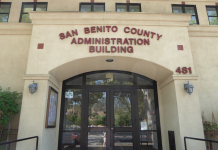Q and A helps explain differences in funding
School officials across the state are holding their collective
breath this morning pending the expected announcement by Gov. Gray
Davis that state aid for education is going to be reduced as part
of efforts to erase a $35 billion deficit over the next 18
months.
School officials across the state are holding their collective breath this morning pending the expected announcement by Gov. Gray Davis that state aid for education is going to be reduced as part of efforts to erase a $35 billion deficit over the next 18 months.
“We know we face a reduction, which potentially could be as much as $850,000,” said Bonnie Branco, deputy superintendent for business in Morgan Hill Unified School District.
A reduction of that magnitude would occur if the Davis proposal for an across-the-board reduction of 2.15 percent for all state-aid districts such as Morgan Hill is actually carried out, Branco said.
“We can’t cover an $850,000 loss. So our only hope is that the state will relax its requirement that school districts maintain a reserve equaling 3 percent of their expenses,” Branco said.
“Without any latitude,” Branco said, “there will be districts all over the state that look like they’re in severe fiscal trouble because of a situation they didn’t create.”
The Morgan Hill district’s 3 percent reserve contains $1.7 million, which could be used to cushion the loss of state revenue, Branco said.
Morgan Hill school officials will start shaping their own budget for next year on the basis of state aid, which could change in coming months.
In an effort to help the public understand school funding and what lies ahead for the district, Branco answered the following questions:
Q. What is the source of school district revenue?
A. Today most money comes from the state, which devised a funding formula following the passage of Proposition 13 by voters statewide in 1978. The measure limited the ability of local school districts and other taxing agencies to raise money.
Q. Was there a state formula prior to 1978?
A. No, because each agency had the power to collect taxes based on assessed valuation of property. If the increase in assessed valuation didn’t produce enough revenue to cover anticipated expenses, the tax rate itself could be increased.
Q. What formula did the state devise?
A. The state formula for school funding was based on the amount of property tax collected in each school district at the time that Proposition 13 was approved. It’s called revenue-limit funding.
Q. Does that mean that school districts don’t receive the same amount of funding?
A. That’s right. Revenue-limit districts, as they’re called, such as Morgan Hill, receive from the state the difference between the amount of money raised by property tax and the per-student amount the state deems necessary for general operating expenses.
Q. What does that mean for Morgan Hill school district?
A. Currently, Morgan Hill’s revenue limit is $5,000 per student, of which $3,500 comes from the state.
Q. Does the revenue limit fluctuate at all?
A. Yes. The revenue limit typically has received a cost-of-living adjustment every year.
Q. Is there another category of school district?
A. Yes. Basic-aid districts receive a limited amount of state money, probably no more than $150 per student, because local property tax revenue exceeds what would be provided by state.
Q. How many basic-aid districts are there?
A. There are 50 to 60 in the state, many of them concentrated in the Bay Area. Los Gatos, Saratoga and Palo Alto are among them.
Q. Do school districts have other sources of funding?
A. Some districts have tax overrides, self-imposed levies earmarked for specific purposes.
Q. Does Morgan Hill have such a special levy?
Q. No. But voters in June 1999 approved $72 million in general obligation bonds to build a new high school, renovate Live Oak High School and build and elementary school.
Q. What is the current budget of Morgan Hill Unified School District?
A. The district has $44 million in discretionary money, which it can spend however it wishes. This revenue pays for salaries, administrative costs and overhead. Additionally, the district budget contains $11 million in restricted revenue – also known as categorical revenue — which means the money must be spent for a specific purpose such as transportation, special education, classes for the mentally gifted and class-size reduction in kindergarten through third-grade.
Q. Does the governor’s proposed aid reduction affect restricted (categorical) revenue?
A. Yes. According to what we know now, restricted funding would be reduced 2 percent.
Q. Does the school district have to provide help – financial or otherwise – to charter schools?
A. For the upcoming year, yes. Since the district passed the bond it is responsible for helping the charter school with its facility needs. Our charter school is making such a request.
Q. What is a low-wealth district?
A. A low-wealth district is one in which the amount of per-pupil funding is below the statewide average. The state periodically recalculates the average and tries to equalize funding with additional funding to poorer districts.
Q. Is Morgan Hill a low-wealth district?
A. Yes. Periodically the district has received equalization funding, but not in quite a while.
Q. Is equalization funding discretionary or categorical?
A. Yes, it is discretionary.









